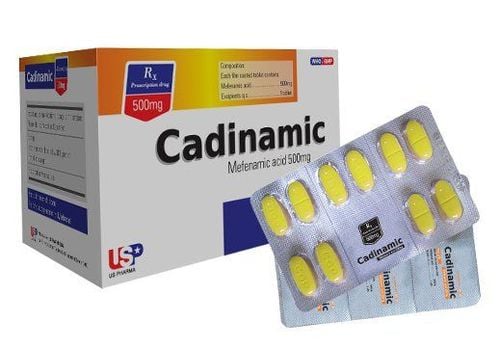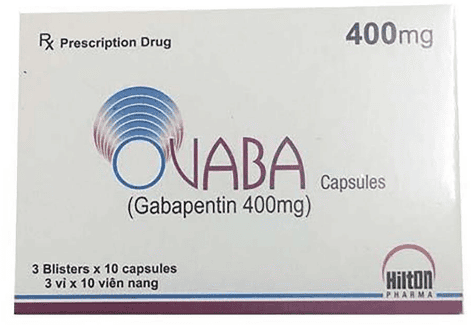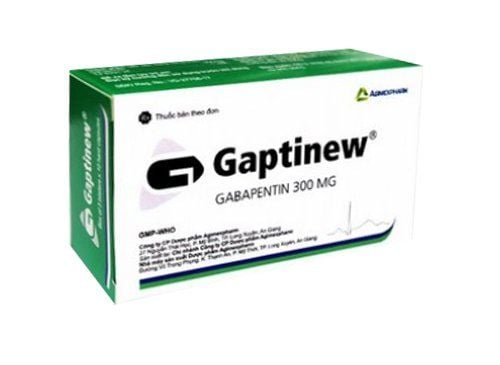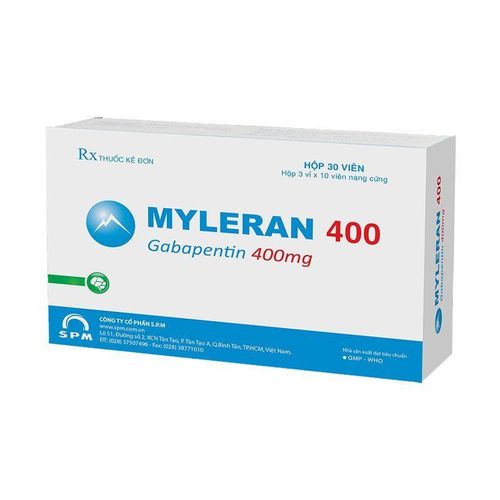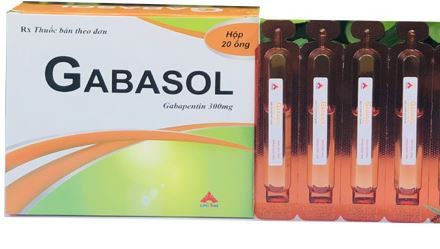This is an automatically translated article.
Neupencap is indicated in the treatment of partial seizures and neuropathic pain. So how to use Neupencap? What precautions should be taken when using this drug? Let's find out the necessary information about the drug Neupencap through the article below.
1. What is Neupencap?
Neupencap is a psychotropic drug with the ingredient Gabapentin. Drugs manufactured by Danapha Pharmaceutical Joint Stock Company circulated in Vietnam and registered with VDK VD-7418-09.
Pharmaceutical name: Neupencap - 300 mg
Classification: Drug
Registration number: VD-7418-09
Drug group: Psychotropic drug
Manufacturer: Danapha Pharmaceutical Joint Stock Company
Ingredients
Gabapentin Drug Neupencap contains the main ingredient Gabapentin, other active ingredients and excipients with just the right amount of medicine provided by the manufacturer.
Dosage form: Tablets
Packing: box of 3 blisters, 10 blisters x 10 capsules
Content:
Need to look carefully at the drug form and content stated on the product packaging or in the instruction sheet for information exact dosage form and content in the product.
2. Uses of the drug Neupencap
Effects
What does Neupencap do?
Gabapentin is structurally related to the neurotransmitter GABA (g-aminobutyric acid) but its mechanism of action differs from a number of other drugs that interact with GABA synapses, including valproate, barbiturates , benzodiazepines, GABA transaminase inhibitors, GABA reuptake inhibitors, GABA receptor agonists and GABA precursors.
Gabapentin at clinically effective doses does not bind to the receptors of other common drugs or to brain neurotransmitters including GABAA, GABAB, benzodiazepine, glutamate, glycine or N-methyl receptors -d-aspartate.
In vitro, gabapentin does not interact with sodium channels and as such it differs from phenytoin and carbamazepine. Gabapentin partially reduced responses to glutamate N-methyl-d-aspartate (NMDA) agonists in several in vitro assay systems, but only at concentrations > 100 mcM which could not achieved above invivo. Gabapentin slightly reduces the release of monoamine-structured neurotransmitters in vitro
Effects, uses of the drug Neupencap - 300mg in other cases
Each type of manufactured pharmaceutical has the main effect to treat some specific disease or condition. That is why only use Neupencap - 300 mg to treat the conditions or conditions specified in the instructions for use. Although Neupencap - 300mg may have some other effects that are not listed on the approved label, you should only use this medicine to treat certain other conditions when directed by your doctor.
2.1 Indications Epilepsy : Gabapentin is indicated as monotherapy in the treatment of partial seizures with or without secondary generalization in adults and children over 12 years of age. The safety and efficacy of gabapentin monotherapy in children under 12 years of age have not been established. Gabapentin is indicated as adjunctive treatment in the treatment of partial seizures with or without secondary generalization in adults and children 3 years of age and older. The safety and efficacy of gabapentin adjunctive therapy in pediatric patients under 3 years of age have not been established. Neuropathic pain: Gabapentin is indicated for the treatment of neuropathic pain in adults 18 years of age and older. The safety and efficacy of gabapentin in patients younger than 18 years of age have not been established.
2.2 How to use - Dosage How to use:
Each drug, pharmaceutical product is produced in different forms and has different ways of using according to the route of administration. The usual routes of drug administration by drug form are: oral drugs, injections, external drugs and suppositories.
Carefully read the instructions on how to use Neupencap - 300mg above from the drug user manual, do not arbitrarily use the drug by other routes not listed on the Neupencap - 300 mg drug instruction sheet.
Dosage:
Gabapentin is taken orally with or without food.
In the treatment of epilepsy (adults and pediatric patients over 12 years of age):
Clinical trials have shown that the effective dose range of gabapentin is 900 to 3600 mg/day. Treatment may be initiated by administering 300 mg three times daily on day 1, or by titration as described in Table 1. The dose may then be increased to a maximum dose of 3600 mg/day in divided doses. do 3 equal times. Doses up to 4800 mg/day have been well tolerated in long-term, open clinical studies. The maximum interval between doses in the three-daily dosing regimen should not exceed 12 hours to avoid flare-ups.
For pediatric patients aged 3 to 12 years: The effective dose of gabapentin is 25-35 mg/kg/day given in 3 equally divided doses (3 times/day) as described in Table 2. Initial dose titration to find an effective dose can be carried out over 3 days using 10 mg/kg/day on day 1; 20 mg/kg/day on day 2 and 30 mg/kg/day on day 3 as described in table 3. The dose can then be increased to a maximum of 35 mg/kg/day divided into 3 equal doses In a long-term clinical study, doses up to 40 to 50 mg/kg/day were also well tolerated.
Monitoring of gabapentin plasma concentrations in order to optimize gabapentin therapy is not necessary. Furthermore, gabapentin can be used in combination with other antiepileptic drugs without regard to changes in gabapentin concentrations or plasma concentrations of other antiepileptic drugs.
If gabapentin treatment is discontinued and/or an alternative anticonvulsant is added, this should be done gradually over a minimum of 1 week.
In the treatment of neuropathic pain in adults: The initial dose is 900 mg/kg divided into 3 equal doses and increased if necessary, depending on response, up to a maximum dose of 3600 mg/day. Treatment should be initiated by titration as described in Table 1.
Dosage adjustment in patients with neuropathic pain or epilepsy with impaired renal function:
Dose adjustment is recommended in patients with impaired renal function. reduced renal function as described in Table 4 and/or in patients undergoing hemodialysis.
Dose adjustment in patients on hemodialysis:
For patients on hemodialysis who have never received gabapentin, an initial dose of 300-400 mg, then reduced to 200-300 mg of gabapentin is recommended. every 4 hours on hemodialysis.
Dosage of the drug Neupencap - 300mg for adults The regulations on dosing are usually intended to guide adults for oral administration. Dosage for other routes is specified in the leaflet. Do not change the dose on your own without consulting your doctor or pharmacist.
Dosage of Neupencap - 300mg for children Differences between children and adults such as pharmacokinetics, pharmacodynamics, side effects... especially children are not allowed to be tested. clinical practice before granting marketing authorization for a new drug. Therefore, using this drug for children should be very careful even with drugs that have not been warned.
2.3 Overdose, missed dose, emergency Overdose:
In case of emergency or overdose with dangerous manifestations, call 911 Emergency Center or go to the nearest local Medical Facility. Relatives need to provide the doctor with the prescription they are taking, the medicines they are taking, including prescription and non-prescription drugs.
Missed dose:
In case you miss a dose while taking the medicine, take it as soon as possible (usually it can be taken 1-2 hours after the time ordered by the doctor). However, if it is almost time for your next dose, skip the missed dose and take your next dose at the prescribed time.
Note do not use double the prescribed dose.
3. Note when using the drug Neupencap
Contraindications
Gabapentin is contraindicated in patients with known hypersensitivity to gabapentin or any of its ingredients.
Note
Although there is no evidence of flare-ups with gabapentin, abrupt discontinuation of anticonvulsants in epileptic patients may precipitate intermittent seizures (state epilepsy) in patients. Once the physician judges that the dose needs to be reduced, discontinued, or replaced with other anticonvulsants, these should be done gradually over a period of at least 1 week.
In general gabapentin is not effective in the treatment of absence seizures.
Effects on ability to drive and use machines
Patients should be advised not to drive or operate potentially hazardous machines until it is ascertained that this drug has no effect on their ability to engage in this activity of theirs.
Pregnant and lactating women
Pregnant women:
There are no adequate and well-controlled studies in pregnant women. Because animal reproduction studies are not always consistent with human responses. This drug should be used during pregnancy only when the potential benefits outweigh the potential risks to the fetus.
Lactation:
Gabapentin is excreted in human milk. The effect of gabapentin on the nursing infant is unknown. Caution should be exercised when gabapentin is administered to nursing mothers. Gabapentin should be used in nursing mothers only if the potential benefits clearly outweigh the possible risks.
Please dial HOTLINE for more information or register for an appointment HERE. Download MyVinmec app to make appointments faster and to manage your bookings easily.





